A tale of two gorgeous maples...sad but true!
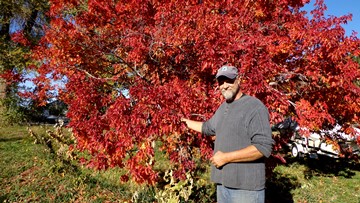 Scott Skogerboe and mystery maple...
Scott Skogerboe and mystery maple...
Everyone should have a hero. Scott Skogerboe has always been one of mine: Head of propagation at Fort Collins Nursery Wholesale, he and his boss, Gary Epstein have been the force behind most of the woody plant introductions of Plant Select. Here he is standing in front of...well...you shall have to wait and see (I have my crafty ways of making you read all the way to the bottom of my blog posting!)....
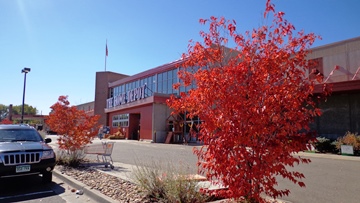 Amur maple at Box Store
Amur maple at Box Store
This is NOT the same maple as the one with Scott above--this is an Amur Maple (Acer ginnala) I photographed today (October 20) on West Colfax in front of a Box Store which I am NOT endorsing (although I confess I did by 50 of awesome plants while I was there...). As the name suggests, Amur maples originate in the Amur river region of East Asia, the river that separates Manchuria from Siberia. No wonder the tree is so cold hardy! But that area is also Maritime--and the soils are podzoils: generally acid, more like the soils of our upper Midwest and New England. So of course, Amur maples in Denver are frequently chlorotic, and usually not recommended by horticulturists "in the know". No one bothered to tell the landscape architects, who filled the vast parking lot of this box store with them--and each and every one of them are blazing in DIFFERENT colors, and looking mighty healthy!
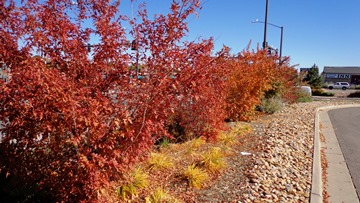 A whole ROW of frickin' amurs
A whole ROW of frickin' amurs
Here you can see bits and pieces of a half dozen Amur maples in blazing color---looked like a regular conflagration! Each was robust, and each a very different shade of flaming red and orange (and some yellow and one or two green--this picture doesn't show them quite right--I'll show some closeups to better demonstrate a wonderful quality that is being increasingly denied people: namely, the wonderful biodiversity and variability that comes with seed grown plants.
 Yellow-orange Amur
Yellow-orange Amur
Although most of these maples were an unalloyed scarlet-vermilion, one was more orange-yellow in tint...
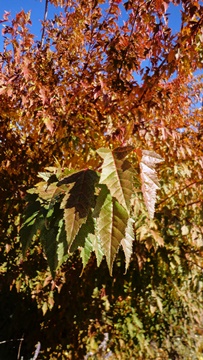 Green leafed Amur
Green leafed Amur
Right alongside all the red ones, one had barely begun to turn and was still mostly green
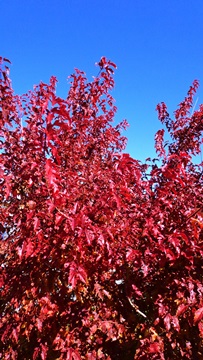 Bright vermilion Amur Maple
Bright vermilion Amur Maple
But of the several dozen Amur maples around the parking lot, most were this flagrant, bracing, wonderful red color that we all love so much in the species. I have seen dozens of Amur maples all around Denver looking this good--there are some massive ones near Denver Botanic Gardens (and I have a pretty awesome specimen in my own garden too--hee hee)...but for every stunning Amur maple, there are usually a few gnarly, miserable things that look awful year around and hardly color up in fall. I have a hunch some of these are simply inferior plants, and others are probably growing in particularly bad sites with more alkaline soils, perhaps, or other environmental problems...Here, you should generate a drum roll and have the summon the cavalry with trumpets! Woo hooo!
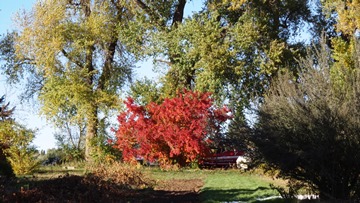 Acer tataricum at Fort Collins Nursery Wholesale
Acer tataricum at Fort Collins Nursery Wholesale
Last Friday, while visiting Scott at Fort Collins Nursery Wholesale, I espied a furiously red small tree in the distance--the same one pictured at the beginning of this posting with Scott standing in front. This is a superb, red-fall coloring Tatarian Maple--a sib to the Plant Select Introduction, Acer tataricum Hot WingsTM. I have observed around town that Hot Wings Maple has been quite reliable about turning a wonderful reddish purple color in most sites. And since it is a selection of Acer tataricum, it will thrive in far more alkaline pedocal soils ("Tatarian" refers to "Tatary"--the archaic term used for "Turkestan", the designation for the portions of Czarist Russia in Central Asia--namely contemporary Kazakhstan, Kirghistan, Uzbekistan and the smaller neighboring "stans" that are now mostly independent states, but formerly parts of Russia and the Soviet Union. Mike Bone and I found Acer tataricum several times in Kazakhstan--many of them with the bright red samaras much like the Plant Select clone...
And here's the rub--you can go to almost any nursery in Colorado (in fact around the United States, Canada and Europe as well) and find Hot Wings in several convenient sizes--which you can purchase and plant in your garden and get not only spectacular fall color, but a shapely small tree the rest of the year which has brilliant red fruits for much of the summer--which look as bright and dazzling as flowers for an extended period: it is apt to thrive for you on acid or alkaline soils, and once established in Colorado thrives with almost no supplemental irrigation: what's not to love?
One of the great ironies of Colorado horticulture is that the ultimate seedsman (Scott Skogerboe) has also developed a number of clonal plants that will one day greatly outnumber the millions of seedlings he has grown in streetscapes and gardens around the world. Such are the ironies of our crazy modern world.
A piece of me wishes we could have developed a seed strain of red-winged maples so we could enjoy the wonderful biodiversity that thrilled me earlier today at Home Depot as I wandered through the Amur maples (imagining what they must look like in their native habitat right now, with the last few Siberian Tigers slinking through them nearby)--wait! What was that orange flash I caught out of the corner of my eye!? For a brief second I felt like Derzu Uzala (you must rent this dazzling Kurosawa classic if you've not seen it yet) and a moist Siberian breeze caressed my cheek.
 English
English Български
Български 简体中文
简体中文 繁體中文
繁體中文 Français
Français Deutsch
Deutsch Italiano
Italiano 日本語
日本語 한국어
한국어 Polski
Polski Português
Português Română
Română Русский
Русский Español
Español Tiếng Việt
Tiếng Việt Монгол
Монгол Afsoomaali
Afsoomaali
Comments
Amur Maples in Colorado
Thank you for this informative and entertaining article on my favorite, the Amur Maple. I am new to this USDA zone and you have helped greatly in my decision making regarding choice of hybrid and soil amendment. Happy Spring! :)
Hot wing maple
It is 4' tall, did great last year..
Leafing now (May) - what if any should I fertlize ? how much ?
Hot Wings Maple Tree
Just had a hot wings maple tree planted this past summer and am trying to find out what time of year or at what point it should be pruned. I certainly don't want to damage it, but want to make sure that lower, small branches growing downward need to be pruned. And if that is the case, at what point in the year should they be pruned? I live in Cheyenne, Wyoming. Your expertise would be greatly appreciated!
Thank you,
Diane Hull.
Proper planting or improper???
1.5 yrs ago I had my yard landscaped and the owner put in Amur maples....one of them died and he replaced it with a new one......BUT I watched the young men that planted it with the roots still in the burlap sac and metal cage around the ball. Do you think this could lead to the Chlorosis that I am seeing now?
Mark R. - Proper vs. Improper planting (Yikes!)
Burlap shouldn't be much of a problem for the tree, since it's porous and will break down over time (though I generally remove it when I plant). The wire basket and/or twine, on the other hand, is a far more serious issue - the "professionals" should have removed it prior to planting the tree. Nylon twine and metal baskets will not break down fast enough to keep from damaging the tree as it grows, leading to health issues and, most likely, an early death. Of course, trees are tough, but so is Colorado. Sounds like they were either lazy or inexperienced (at least that's what one professional website says - they would recommend digging up the tree and replanting it (properly) in winter or early spring (probably after the leaves have fallen in late fall/early winter or before the new growth begins in early spring here in Colorado). As for chlorosis, the tree's health might be influencing how chlorotic it is, especially if the roots are being severely constricted, but maples (well, most maples) and chlorosis seems to be an eventuality in Colorado soils regardless of how well it is planted. A good arborist should be able to help with the tree's nutrition and environment, but you'll probably have to dig the tree up to determine its root health (and, if necessary, to fix it). Disclaimer: I'm not an arborist, just a plant nerd. I do know that a healthy root system is critical to a healthy (and long-lived) tree.
Acer tataricum
I bought Tree in a gallon pot in the end of season sale. It made it through the winter buried in mulch. Now I would like to plant it as a bonsai. Should I design it (prune) it now and leave it in its gallon pot or plant in a training pot which would involve some root pruning? Could I do both now or would that be too much of a shock? Thx for your insight. CC
Armur maple not good near concrete patios
Our armur maple was planted by Earl May maybe 10 hrs ago, but not until last summer did I see black stains on our patio where the samaras had blown there in a rain storm. As the seeds dried, the black stems bled black and stained the concrete, looking as though fireworks “snakes” had been lit in those spots. I tried to brush scrub the concrete with numerous cleaning products, but nothing but months of summer sunlight would fade the mess. It was a very poor selection for numerous other reasons and several times my husband threatened to have it taken out. This was not the shorter, spreading tree we had admired on the Earl May property—that store associate misidentified that by a long shot. Bad tree!
Amur maple
Dear Jean, Thanks for alerting us to that issue. I had no idea that they would stain so severely: I wonder if it's every Amur or certain strains? I will be sure to tell others from here on out!
I have a Amur Maple for ten
I have a Amur Maple for ten years by my driveway; I do not have that stain problems. It is a gorgeous tree.
Cataract problem?
Prune it back every other year for about 2-3 years (its a fast grower) and you will enjoy a beautiful, multi-colored fall tree/bush of about 15+ ft. tall that provides great privacy for your backyard, especially when in its spectacular fall colors.
Don't pay any attention to the pics and comments provided here, the provider thereof has a nasty and unexplainable chip on his shoulder (he propably hates robins too) and a very lousy eye for trees.
High elevation?
Most of these maples are documented as having a max elevation of 7000’. I live in Grand Lake at 8500’ and have been trying to find something to break the monotony of aspen aspen pine spruce aspen... Is it worth a try gambling on this species at this elevation?
Amur maple
I suspect these maples COULD grow for you, but if you REALLY want diversity, I'd go for almost any Birch (especially our native river birch or one of the white barked kinds), or how about Larch? I think most any of these would thrive for you at Grand Lake and really look different. I was just in Tibet and saw dozens of broadleaf and coniferous tree species growing at 14,000-15,000 that would probably be reliable for you as well--just start with small, inexpensive ones and select for hardiness!
Acer ginnala 'flame' and tataricum 'hot wings' cross
Have you seen any crosses of the acer ginnala 'flame' and the acer tataricum 'hot wings'? I am growing both of these near each other and a small volunteer maple started rapidly growing not far from them. It looks more like a ginnala 'flame' in color and in most of the leaves, but some of the leaves have the 'hot wings' look. So far it has not produced any seed pods, since it has only been around for a couple of seasons, but I'm curious if it is possible for the two maples to cross (neither are sterile, are they?) or if most likely the ginnala is the parent.
Hot Wings & BONUS movie recomendation!
Thanks Roger, enjoyed learning about the beautiful hot wings trees and getting your BONUS movie recommendation:DERZU UZALA. Great time for a little vicarious travel to Siberia & re-learning how to plant seeds of kindness! Best regards during pandemicky times, Les
Live in foothills above Boulder - maple tree?
Hi.
We'd like to plant a colorful tree. We live at 7000 ft. What do you recommend? Maples?
Thanks,
megan
Maple Recommendation
Hi Megan,
Contact Colorado Master Gardeners at gardeninghelp@botanicgardens.org. They should be able to help you with a recommendation.
Tiffany
Add new comment